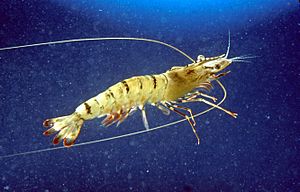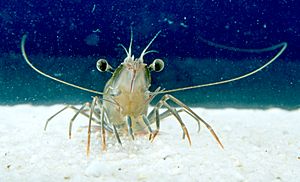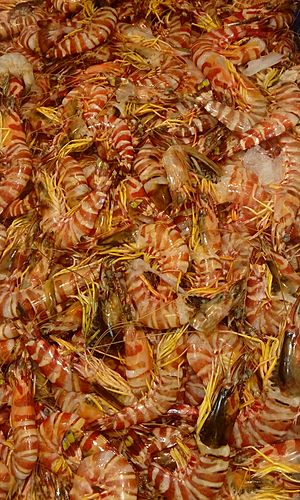Giant tiger prawn facts for kids
Quick facts for kids Giant tiger prawn |
|
|---|---|
 |
|
 |
|
| Scientific classification | |
| Synonyms | |
|
The giant tiger prawn (also known as the Asian tiger shrimp or black tiger shrimp) is a large type of crustacean that lives in the ocean. People around the world raise these prawns for food because they are a popular seafood choice.
Contents
Understanding Giant Tiger Prawns
What is a Giant Tiger Prawn?
Giant tiger prawns are a kind of shrimp. They are known for their large size and the striped patterns on their bodies, which look a bit like tiger stripes. These stripes are usually red and white.
How Big Do They Get?
Female giant tiger prawns can grow quite large, often reaching about 25 to 30 centimeters (about 10 to 12 inches) long. They can weigh between 200 and 320 grams (about 7 to 11 ounces). Males are a bit smaller, usually 20 to 25 centimeters (about 8 to 10 inches) long and weighing 100 to 170 grams (about 3.5 to 6 ounces).
Where Do Giant Tiger Prawns Live?
Naturally, these prawns live in the Indo-Pacific region. This area stretches from the eastern coast of Africa and the Arabian Peninsula, across Southeast Asia, and into the Pacific Ocean and northern Australia.
Giant tiger prawns are very adaptable. Young prawns often live in sandy estuaries and mangrove areas. As they grow into adults, they move to deeper ocean waters, usually between 0 and 110 meters (about 0 to 360 feet) deep. They prefer muddy or rocky bottoms.
What Do They Eat?
These prawns are active at night. During the day, they often burrow into the sand or mud to hide. At night, they come out to find food. They eat many things, including detritus (dead organic matter), worms, mollusks (like snails or clams), and small crustaceans. They also eat algae.
Giant Tiger Prawns as an Invasive Species
Sometimes, animals are introduced to new places where they don't naturally belong. When they cause harm to the new environment, they are called an invasive species.
How Did They Become Invasive?
Giant tiger prawns first appeared in U.S. waters in 1988. About 300 prawns escaped from a shrimp farm after an accident. Since then, they have been found in waters from Texas to North Carolina. Even though they have been around for many years, they haven't formed very large populations in the U.S. However, in other parts of the world, like West Africa, Brazil, and the Caribbean, escaped prawns have created new, established populations.
Farming Giant Tiger Prawns
Why Are They Farmed?
The giant tiger prawn is one of the most commonly farmed prawn species in the world. People like to farm them because they grow very quickly and can live in water with different salt levels. In 2009, over 770,000 tonnes of these prawns were produced for food, worth billions of dollars.
Challenges in Farming
Even though they grow fast, giant tiger prawns can get sick easily. They are vulnerable to infections caused by fungi, viruses, and bacteria. Diseases like white spot disease and yellowhead disease have caused big problems for shrimp farms globally. These diseases can even spread from other crustaceans, like the Australian red claw crayfish, to the prawns.
Because of these disease risks, scientists are trying to breed special types of giant tiger prawns that are stronger and can resist these illnesses.
Farming Conditions
For the best growth, giant tiger prawns are usually raised in water that is between 28 and 33°C (about 82 to 91°F). They can survive in a wide range of saltiness, but they grow best when the water has a medium amount of salt. On farms, they are typically fed special dried pellets. Some farmers also mix in fresh food, which helps the prawns reproduce better.
Sustainable Seafood Choices
In 2010, an organization called Greenpeace added the giant tiger prawn to its "seafood red list." This list includes fish and seafood that are often sold in stores but might come from farming or fishing methods that harm the environment.
Greenpeace raised concerns that farming giant tiger prawns can lead to:
- The destruction of large areas of mangroves, which are important coastal forests.
- Overfishing of young prawns from the wild to supply farms.
- Serious human rights issues in some farming operations.
These concerns highlight the importance of choosing seafood that is caught or farmed in ways that protect our planet and its people.
See also
 In Spanish: Langostino jumbo para niños
In Spanish: Langostino jumbo para niños


